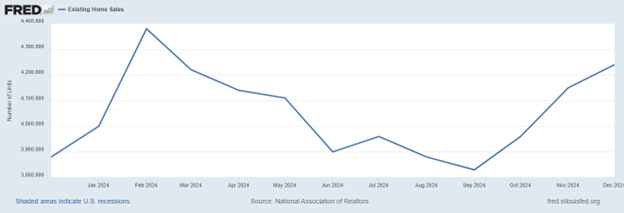Federal Overspending Created the Housing Crunch
Deregulation is critical, as Trump observes, especially on the state level. However, it is not nearly enough.
Americans fortunate enough to own a home are staying put, and those in the market to move are out of luck. Home sales are now at their lowest level in nearly 30 years, The Wall Street Journal reports:
U.S. existing-home sales fell in 2024 to the lowest level since 1995, the second straight year of anemic sales due to stubbornly high mortgage rates.
High costs related to homeownership sapped sales again. The average rate for a 30-year fixed mortgage has hovered between 6% and 8% since late 2022, making it prohibitively expensive for many Americans to buy homes at current prices, which hit record highs last year. Rising home insurance and property tax costs are also adding to homeowners’ expenses.
This was all caused by excessive spending by the federal government. The spike in inflation during the Biden years spurred the Federal Reserve to tighten the money supply by imposing rapid increases in interest rates and asset sales:
Source: Federal Reserve
This led to a swift rise in mortgage interest rates:
Since the monetary tightening of 2023 and much of 2024, interest rates have remained stuck far above the Federal Reserve's presumed goal. The current average rate for a 30-year fixed-rate mortgage is 7.04 percent. That is nearly double the average rate of 3.74 percent at the end of 2019 and nearly three times the 2.67 percent average at the end of the pandemic year 2020.
The big increase in mortgage interest costs led to a decrease in the number of homes for sale, because people with mortgages from the left side of the chart above, and before that, have been reluctant to sell and take on a new loan with a much higher interest rate:
The shortage is severe, The Epoch Times reports:
Freddie Mac estimates a shortage of 3.7 million units in the United States as of the third quarter of 2024. This was only a small dip from the 3.8 million shortage roughly four years back in the fourth quarter of 2020.
The supply crunch spurred price increases:
As the Wall Street Journal article reports, “Existing-home sales fell 0.7% in 2024 from the prior year to 4.06 million, the National Association of Realtors said Friday.”
Price hikes are the problem, the Journal story confirms:
The national median existing-home price in December was $404,400. That is down from the record high of $426,900 reached in June but represents a 6% increase from December 2023, NAR said.
“How is it that home sales are so low while home prices are so high?” said Lawrence Yun, NAR’s chief economist. “Inventory appears to be a big factor driving sales.”
Excessive regulation on the state and local level is causing a dearth of housing in many cities, especially in Democrat-run states (which tend to overregulate), and there are other factors holding down the addition of new housing to the supply. With that in mind, President Trump signed an executive order last week directing the federal government to encourage housing affordability, zeroing in on the need for regulatory relief:
Unprecedented regulatory oppression from the Biden Administration is estimated to have imposed almost $50,000 in costs on the average American household, whereas my first-term agenda reduced regulatory costs by almost $11,000 per household.
Trump refrained from offering taxpayer money to homeowners, which would only drive up the cost of housing further by increasing the amount of money available to be spent on it and raising the federal deficit and inflation. The Epoch Times story quotes Realtor Senior Economist Joel Berner as saying, “absent here [in the order] is any mention of supporting prospective homebuyers with funds toward their purchase, which we are in agreement with, as these subsidies would simply result in higher home prices. Bolstering home supply is the true long-term solution.”
Deregulation is critical, as Trump observes, especially on the state level. However, it is not nearly enough. The main cause of the problem is the drawn-out effect of excessive federal spending during the Biden years. The only way to reverse that process is to cut federal spending and tax rates significantly and let the American people build, baby, build.
Fortunately, Trump seems determined to do that as well.








